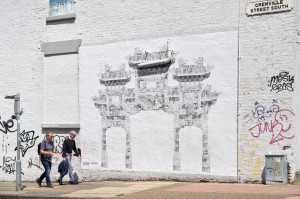Carreg Ateb: Vision or Dream? Reviewed

Continuing a run of superb exhibitions, Mostyn Gallery in Llandudno hosts Jeremy Deller’s ode to Welsh culture. Laura Robertson finds echoes of and reverie in many versions of the past, a playful and critical tribute to art and selfhood…
Carreg Ateb: Vision or Dream? ‘Carreg Ateb’, translated from the Welsh for answering stone, or echo stone; a rock to cause a call to action, or a reverie, as the phase suggests? An echo, a solution, or a firm resolution? The original Carreg Ateb is a capstone from a prehistoric burial chamber, situated on the Pembrokeshire coast, which the local Abbott would strike in order to bless fishing boats going out to sea, and to protect those souls going out to dangerous work, wild weather, and for the unknowable catch.
The title of Jeremy Deller’s new exhibition at Mostyn Gallery in North Wales throws up a barrage of thoughts before you even cross the threshold. The exhibition title is immortalised in a patchwork banner by Deller’s long-term collaborator, Ed Hall, who’s been making trade union campaign and exhibition banners with the artist for 25 years. The political tone of Carreg Ateb: Vision or Dream? points, in a fittingly dreamlike way, to Welsh culture today and yesterday, and the repair of culture after a slow, insidious oppression by English power or powers.
The show is a gentle drip-drip of these ideas. As usual, Mostyn Gallerys’s natural light and vaulted ceilings make for a space that allows art to breathe, crucial in allowing visitors to observe craft pieces, heirlooms, artefacts, and new work by young Welsh artists that poke and prod at what the artistic self might mean, given the tools, materials and subject matter specific to nation.

Here are many objects that rouse curiosity and awe: including Astronomical Slates (1837) carved by brothers Thomas and William Jones, of Bryn Twrw, Tregarth, quarrymen and farmers: the cosmos and its meanings depicted with tremendous care on a material prone to shatter. A decorated horse jaw, originally and accidently unearthed by Thomas Kendrick as he was digging in his garden on the Great Orme cliffs (1880); Kendrick’s cave, as it came to be known, contained the jaw as well as flint, bear teeth, and human bones, believed to be from the Upper Paleolithic era. The famous Wrexham Tailor’s Quilt by James Williams (1842-1852): 4,525 pieces of felted woollens and military uniforms, meticulously sewn offcuts depicting an array of Biblical stories, including Adam with exotic animals in the Garden of Eden, and Jonah and the Whale.
Here, also, are very recent stories: a film installation with poster, Llwyfan Beca (2025) by Esyllt Angharad Lewis, or Beca’s Stage, portraying a young girl in cockle bonnet and dress, performing the past, alongside other schoolchildren. The poster reads ‘Cyfiiawnder a charwyr cyfiawnder ydym ni oll’, meaning, Justice and the lovers (holders) of justice we all are; alluding to the Justice and the Lovers tarot cards, a combination that indicates clarity, honesty and self-discovery. Lewis Prosser’s buff willow baskets, mace, urns and collars (2025) are another unexpected way of channelling historic procession; civic regalia for today made with a skill he taught himself in Lockdown. At first glance, they could be on loan from local museums and collections.

Later, Prosser’s wicker costumes, and those by artist and filmmaker Edith Morris, are worn by local children from the Frân Wen theatre company in a carnival-esque march along the promenade and through the streets – little legs dance underneath uncanny giant basket heads, and little heads shake fringed animal masks, to the beat of a brass band playing Daft Punk.
In opposition, there are items on display that rouse and shame: a Welsh Not wooden board, a tool of punishment and humiliation, hung around schoolchildren’s necks if caught speaking Welsh; old school books of British history rooted in Crown and Empire, where the Welsh ‘people belong to a different race from the English’; Ian Campbell’s appliqué banner, asking ‘A OES HEDDWCH?’, Is there peace?

Strangeness and joy connect performance to exhibit. Deller’s Folk Archives show raves in the mines, the ribboned horse-head of Mari Lwyd riding in a taxi, and, again unexpectedly, his collection of fan art about Caerphilly’s best rock band, Manic Street Preachers. Relationships emerge with broader legends, as in Manod quarry, which housed the nation’s art during WW2 on Churchill’s insistence, and whose archives were inspiration for this show; in Welsh mythology, The Mabinogion, and in the in-between realms; to Bryn Celli Ddu Burial Chamber on the Welsh island of Anglesey, which we visited the next day to see Frân Wen continue their revelry for the summer solstice. In the driving rain, children bounce up and down the burial mound, singing, arms reaching to the sky, welcoming the return of light to the land.
It is a complex and hypnotic version of the Carreg Ateb, or answering stone, that is presented, if you are open to receive it. Truth is underlined by folklore. The show builds layers of meaning until the tensions of old and new, of pretence and play, reach a climax; echoes of a sort, of mismatched expectations, of what the Welsh culture actually is in the minds of the Welsh, as opposed to the English, who have historically corralled them into the social and cultural categories of ‘other’.
Laura Robertson
See the exhibition Carreg Ateb: Vision or Dream? at Mostyn, Llandudno, until 27 September 2025 – free entry
Presented by Mostyn and Frân Wen’s Young Company as part of a celebration commission curated by Jeremy Deller to celebrate The National Gallery’s bicentenary. With Storiel Bangor, Llandudno Museum, the CARN network, and Cadw, the Welsh Government’s historic environment service
See live performances, The Triumph of Art: A free party in Trafalgar Square, 11am-4pm, Saturday 26 July in London’s Trafalgar Square
Image credits: installation shots by Rob Battersby; live performance shots by Mark McNulty. 2025. With thanks





